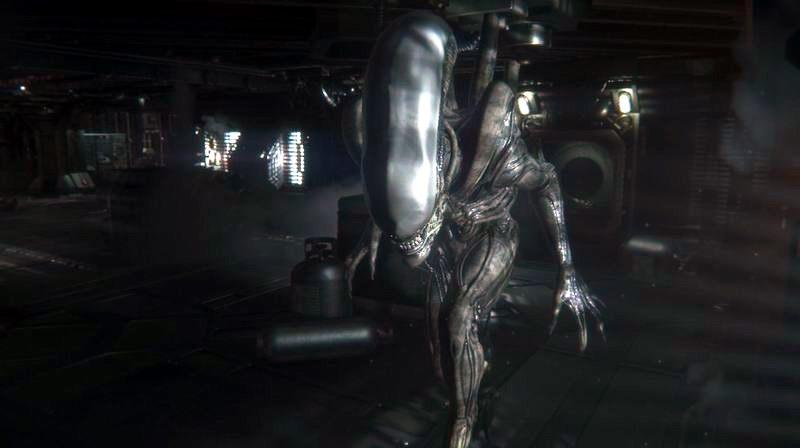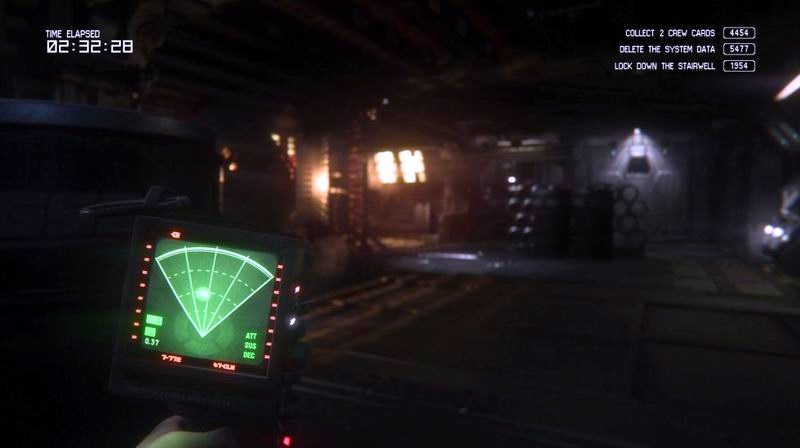Alien: Isolation | reviews, news & interviews
Alien: Isolation
Alien: Isolation
Stealth and horror mix in this often unnerving resurrection of the iconic enemy…

The iconic monster is back in a far more successful way than Prometheus. The first-person, stealth game Alien: Isolation largely successfully returns us to the creeping horror and claustrophobic environments of the original film.
Set after the events of Alien, Isolation sees Ripley's daughter chasing the black box recorder of the original spaceship, the Nostromo. On reaching the space station it's on, of course she finds the iconic "xenomorph", the "perfect organism, its structural perfection is matched only by its hostility", let loose among a terrified and splintered population.
The result is a game that plays soft on the weapons and fights. Yes, you get a gun – but it's not much use except in tight squeezes against other humans. You also get to craft makeshift weapons – Molotov cocktails, grenades, traps etc. But these aren't to kill the alien, merely distract it while you escape or to use on lesser enemies.
 Instead, the majority of gameplay in Alien: Isolation is to be found in crouching in a cupboard, or crawling under a desk or through a darkened vent, with a motion-tracker pinging away as the alien hunts for you. This turns out to be in turns both terrifyingly brilliant and rather boringly difficult.
Instead, the majority of gameplay in Alien: Isolation is to be found in crouching in a cupboard, or crawling under a desk or through a darkened vent, with a motion-tracker pinging away as the alien hunts for you. This turns out to be in turns both terrifyingly brilliant and rather boringly difficult.
When it all works, which is much of the time, Alien: Isolation sees you scurrying from spot to spot trying to avoid the alien, and also lethally-programmed station androids and human gangs out to ensure their own survival. The station, designed to resemble the environments of the first two films, is artfully retro-futurist and suitably dishevelled. You'll be crouching beneath a desk covered in plastic cups and blood, as the tracker starts pinging faster and faster, and then you'll catch a glimpse of black, slimy legs slithering past.
The problems with the game do really dent this tense atmosphere though. To save your progress you have to find a telephone and not have the alien nearby. It's a theoretically clever retro touch, but all it really does is force you to repeat sections over and over hoping you get the right combination of alien movement and yours ‑ the game artificially inflating the space between save points.
 The alien – powered by artificial intelligence, rather than walking a preset path – also veers between being too unpredictable (increasing the difficulty) and being too dumb at times. It can blank you – if you crouch still it will often not see you in its peripheral vision. It can also get stuck. Realising after five minutes stuck hiding in a clothing locker that the alien paused, breathing, in front of you isn't just to heighten dramatic tension, but because of a bug, is boring and annoying.
The alien – powered by artificial intelligence, rather than walking a preset path – also veers between being too unpredictable (increasing the difficulty) and being too dumb at times. It can blank you – if you crouch still it will often not see you in its peripheral vision. It can also get stuck. Realising after five minutes stuck hiding in a clothing locker that the alien paused, breathing, in front of you isn't just to heighten dramatic tension, but because of a bug, is boring and annoying.
The final result alternates between great set pieces that use the alien sparingly and well, and often awkward and humdrum areas. But as a return to form for the franchise, it's a great start.
- Alien: Isolation is out on October 7 for PC, PS3, PS4, Xbox One, Xbox 360. Version tested PS4. Developed by Creative Assembly, published by Sega.
- Read other gaming reviews on theartsdesk
- Simon Munk on Twitter
The future of Arts Journalism
You can stop theartsdesk.com closing!
We urgently need financing to survive. Our fundraising drive has thus far raised £49,000 but we need to reach £100,000 or we will be forced to close. Please contribute here: https://gofund.me/c3f6033d
And if you can forward this information to anyone who might assist, we’d be grateful.

Subscribe to theartsdesk.com
Thank you for continuing to read our work on theartsdesk.com. For unlimited access to every article in its entirety, including our archive of more than 15,000 pieces, we're asking for £5 per month or £40 per year. We feel it's a very good deal, and hope you do too.
To take a subscription now simply click here.
And if you're looking for that extra gift for a friend or family member, why not treat them to a theartsdesk.com gift subscription?
more Gaming
 'We are bowled over!' Thank you for your messages of love and support
Much-appreciated words of commendation from readers and the cultural community
'We are bowled over!' Thank you for your messages of love and support
Much-appreciated words of commendation from readers and the cultural community
 Kelly Clancy: Playing with Reality - How Games Shape Our World review - how far games go back
The acclaimed neuroscientist on the world and history of games, in all their variety
Kelly Clancy: Playing with Reality - How Games Shape Our World review - how far games go back
The acclaimed neuroscientist on the world and history of games, in all their variety
 Rage 2 review – garish but great post-apocalyptic shooter
Challenge The Authority in this 'Mad Max on mushrooms' renegade romp
Rage 2 review – garish but great post-apocalyptic shooter
Challenge The Authority in this 'Mad Max on mushrooms' renegade romp
 World War Z review - bloodthirsty fun with the zombie apocalypse
Chainsawing the brain-eaters as you battle against the tide of the undead
World War Z review - bloodthirsty fun with the zombie apocalypse
Chainsawing the brain-eaters as you battle against the tide of the undead
 The Lego Movie 2 Videogame review - everything is not awesome
Few fresh ideas means this movie adaptation treads the same old ground
The Lego Movie 2 Videogame review - everything is not awesome
Few fresh ideas means this movie adaptation treads the same old ground
 Anthem review - singing praises? More like a cautious nod
A rocky start for a new franchise that offers potential and problems in equal measure
Anthem review - singing praises? More like a cautious nod
A rocky start for a new franchise that offers potential and problems in equal measure
 Crackdown 3 review - spectacular super-powered action that was great fun many years ago
Nearly a decade has passed since the last incarnation but little has changed in this stagnant shooter
Crackdown 3 review - spectacular super-powered action that was great fun many years ago
Nearly a decade has passed since the last incarnation but little has changed in this stagnant shooter
 Battlefield V review - WWII on an epic scale
The veteran series returns for another ambitious tour of duty
Battlefield V review - WWII on an epic scale
The veteran series returns for another ambitious tour of duty
 Fallout 76 review - how to wreck a perfectly good legacy with one messy game
When home runs go horribly wrong
Fallout 76 review - how to wreck a perfectly good legacy with one messy game
When home runs go horribly wrong
 Red Dead Redemption 2 review - the cowboy drama makes a triumphant return
An ambitious Wild West odyssey that matches epic scale with benchmark skill
Red Dead Redemption 2 review - the cowboy drama makes a triumphant return
An ambitious Wild West odyssey that matches epic scale with benchmark skill
 Call of Duty: Black Ops 4 review – less is more
Solo rations have been relegated from this benchmark war series
Call of Duty: Black Ops 4 review – less is more
Solo rations have been relegated from this benchmark war series
 FIFA 19 review - the best just got a bit better
It looks and plays great, but what’s new?
FIFA 19 review - the best just got a bit better
It looks and plays great, but what’s new?

Add comment